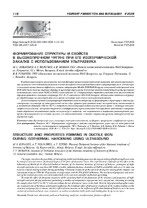Формирование структуры и свойств в высокопрочном чугуне при его изотермической закалке с использованием ультразвука

Date
2020Publisher
Another Title
Structure and properties forming in ductile iron during isothermal hardening using ultrasound
Bibliographic entry
Ковалько, М. С. Формирование структуры и свойств в высокопрочном чугуне при его изотермической закалке с использованием ультразвука = Structure and properties forming in ductile iron during isothermal hardening using ultrasound / М. С. Ковалько [и др.] // Литье и металлургия. – 2020. – № 4. – С. 118-124.
Abstract
В работе рассмотрена возможность интенсификации процессов изотермической выдержки при закалке высокопрочных чугунов за счет использования внешнего источника физического воздействия в виде ультразвуковых волн. Для экспериментальной оценки данного эффекта в условиях лаборатории МиАМ ФТИ НАН Беларуси в тигельной индукционной печи ИСВ 0,004 были отлиты опытные образцы из высокопрочных чугунов. В качестве жидкой охлаждающей среды при закалке использовалась смесь солей NaNО2 и KNO3 в соотношении 1:1. Ультразвуковую обработку расплава соли при охлаждении образцов проводили с помощью генератора УЗГ-20–15 совместно с ИТА НАН Беларуси. Механические свойства и структуру обработанных чугунов определяли как в литом состоянии, так и после изотермической закалки. Для исследования влияния ультразвуковой обработки закалочной ванны на формирование структуры и свойств высокопрочных чугунов при их изотермической закалке был проведен ряд сравнительных экспериментов, заключающихся в охлаждении образцов с 910 до 350 ºС с подводом и без использования динамических волн к ванне. С помощью металлографического анализа, измерений твердости и коэффициента трения показано благоприятное воздействие ультразвуковой обработки охлаждающей среды на структуру и свойства, что отражается в повышении равномерности распределения твердости по сечению чугуна и его износостойкости, а также сокращении времени изотермической выдержки до 2 раз.
Abstract in another language
The paper considers the possibility of intensifying isothermal holding processes during quenching of high-strength cast irons by using an external source of physical impact in the form of ultrasonic waves. For experimental evaluation of this effect in the laboratory of MiAM of the Physical-Technical Institute of the National Academy of Sciences of Belarus, prototypes of highstrength cast irons were cast in an ISV 0.004 crucible induction furnace. A mixture of NaNO2 and KNO3 salts in a 1:1 ratio was used as a liquid cooling medium during quenching. Ultrasonic treatment of the salt melt during the cooling of the samples was carried out using an UZG‑20–15 generator in cooperation with the ITA of NAS of Belarus. The mechanical properties and structure of the treated cast irons were determined both in the cast state and after isothermal quenching. To study the effect of ultrasonic treatment of the quenching bath on the formation of the structure and properties of highstrength cast irons during isothermal quenching, a number of comparative experiments were carried out, consisting in cooling the samples from 910 °C to 350 °C with and without the use of dynamic waves to the bath. With the help of metallographic analysis, measurements of hardness and friction coefficient, the beneficial effect of ultrasonic treatment of the cooling medium on the structure and properties is shown, which is reflected in an increase in the uniformity of the distribution of hardness over the cross section of cast iron and in its wear resistance, as well as a reduction in the isothermal holding time by up to two times.
View/
Collections
- №4[19]
